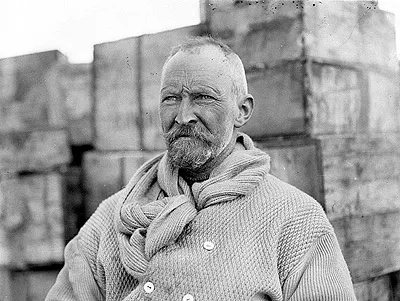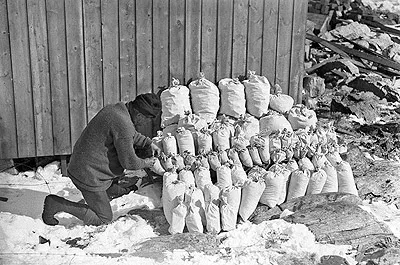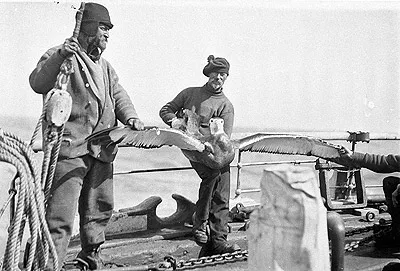John Henry Collinson Close (1871 - 1942)
Biographical
Notes
Assistant Collector - Aurora 1911-1913

From David Deasey
"His service history has become somewhat garbled on some websites, here is a better synopsis:
Enlisted in BSAP (British South Africa Police - Rhodes own private army for control of Rhodesia) during the Matabele revolt 1896 awarded British South African Co medal with clasp Rhodesia 1896
He was possibly a Jamieson raider?
Enlisted Kitchener's Fighting Scouts during the Boer war as a Squadron Sergeant Major
CLOSE, John Henry 120 Sqn. Sergeant Major 1st Kitchener's Fighting Scouts WO127/12 Extract (Colin Roe) Roll Images
Awarded Queens South African Medal (QSA) and clasps Tvl, OFS and CC
After the Boer War he was teaching physical culture in Sydney.
An Antarctic expeditioner with Sir Douglas Mawson from 1912-1914, Close was a member of the Main Base Party (Adelie Land) and several sledging parties.
He spent two summers and one winter in the Antarctic.
In one of the sledging journeys, Close was instrumental in saving his own life and that of his two companions, Frank Stillwell and Charles Laseron. The group were about to enjoy a hot breakfast at 'Aladdin's Cave' - a shelter dug out of the snow on the plateau above Cape Denison - when Stillwell and Laseron suddenly collapsed unconscious. Realising that accumulating carbon monoxide was threatening their lives, Close thrust an ice axe through the snow blocking the cave's entrance before blacking out himself. The deadly gas escaped through the small hole, allowing the three men to regain consciousness and make a slow recovery.
Polar Medal & clasp ANTARCTIC 1912 & 14 The Museum of Victoria holds his medals and Memorabilia."
From Chris Davies
D.H.C Close with almost 100% certainty trained the Aurora crew members as he was a Physical Culture instructor.
My great-grandfather was Eugen Sandow the famous Body-Builder ( 1867-1925 ) who donated to both Shackleton and Mawson. Sandow was at the Royal Theatre in Drury Lane, London with Mawson in May 1911 watching Lytton-Bulwer's comedy " Money " . Sandow subsequently donated £1050 to Mawson who he saw as the ideal physical type !
Sandow's methods were used by expedition members Adams and Marshall on Shackleton's Nimrod expedition (see page 144 "Heart of the Antarctic"), and I am as good as certain that D.H.Close was a devotee of Sandow and used his methods in Sydney at the Australian School of Physical Culture 1911. Certainly he would have been the obvious candidate to get the men fit for Mawson's arduous and rather ill-fated adventure in the windy wastes of East Antarctica. Sandow did a much publicised tour of Australia and New Zealand in 1904-5 and his influence was without parallel.
However I do not have much detail on Close with regards to his Physical Culture exploits and what he actually might have done with regards to training the men. I would be particularly interested in whether they took Sandow Expanders and Spring-Grip Dumbbells on board, or an exercise chart from Sandow's bestseller "Strength and how to Obtain it" !
Landmarks named after John H. Close
Feature Name: Close Islands
Feature Type: island
Latitude: 6701S
Longitude: 14427E
Description: A cluster
of about three small islands lying in the western part of the
entrance to Buchanan Bay. Discovered by the AAE (1911-l4) under
Douglas Mawson.
References to John
Close in Mawson's book "The Home of the Blizzard"
buy USA |
buy UK |
free world delivery
-
Whilst others were occupied finishing off the interior of the hut, Whetter and Close sledged the cases of stores across from the landing-stage, classified them and stacked them against the veranda walls. An additional barricade was constructed of flour cases, in the form of a wall, which increased the breadth of the rocky break-wind on the southern side.
-
Much time was spent endeavouring to make it drift-tight; but as the materials at our disposal were very limited, the result was never absolutely satisfactory. The small veranda serving as an entrance-porch was deluged with snow which drove in past the canvas doorway. The only way to get over this trouble was to shovel out the accumulations every morning. On one occasion, when Close was nightwatchman, the drift poured through in such volume that each time he wished to go outside it took him half an hour to dig his way out. On account of this periodic influx, the vestibule doorway to the workroom was moved to the other end of the wall, where the invading snow had farther to travel and was consequently less obstructive.
-
"By 4 P.M. on the 15th we had reached twenty-five miles and were exhausted. We pitched camp at an early hour, partly influenced by the fact that it was a special occasion - Close's birthday! Some port wine had been slipped in to provide against that 'emergency.' On taking the precious bottle from the instrument-box, I found that the cork was out, and, for one awful moment, thought the bottle was empty. Then I realized that the wine had frozen solid and had pushed the cork out by its expansion on solidification.
"At last, the tent safely pitched and hoosh and cocoa finished, the moment came to drink to Close's health and happiness. The bottle had stood on the top of the cooker while the meal was being prepared, but the wine was still as solid as ever. After being shaken and held over the primus for a good half-hour it began to issue in lumps. Once the lumps were secured in mugs the rest of the thawing was easy. Finally, we toasted Close and his wife (in far Australia) in what we voted to be the finest draught it had ever been our good fortune to drink. In the morning a cairn was made of the snow-blocks which were taken from the tent-skirt, and it was surmounted with the bottle, being called 'Birthday Camp.'
-
Forewarned on the first journey of the dangers of bad ventilation, they cleared the entrance to the cave of obstacles so that a ready exit could be made, if, as was expected, the opening became sealed with snow-drift. This did happen during the night, and, though everything seemed all right the next morning, the whole party was overpowered during breakfast by foul air, the presence of which was not suspected.
Hoosh was cooked and about to be served, when Stillwell, who was in charge of the primus, collapsed. Close immediately seized an ice-axe, stood up, thrust its point through the choked entrance, and fell down, overcome. Laseron became powerless at the same time. An hour and a half later - so it was reckoned - the party revived and cleared the opening. The hole made by the ice-axe had been sufficient to save their lives. For a day they were too weak and exhausted to travel, so the tent was pitched and the night spent outside the Cave.
Biographical information
- I am concentrating on the Polar experiences of the men involved.
Any further information or pictures visitors may have will be gratefully received.
Please email
- Paul Ward, webmaster.
What are the chances that my ancestor was an unsung part of the Heroic Age
of Antarctic Exploration?

